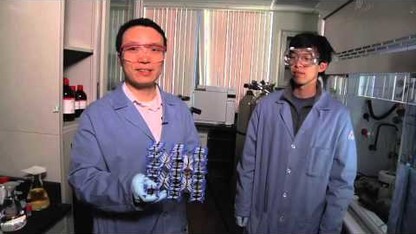
Clean energy fuels—while far “cleaner” than fossil fuels—aren’t as sustainable as they could be, often requiring toxic metals to produce them. A UNL chemist is truly going green, looking to photosynthesis for inspiration to create the cleanest fuels and other chemicals possible.
Jian Zhang, assistant professor of chemistry, recently earned a five-year, $527,154 Faculty Early Career Development Program Award from the National Science Foundation to develop an organic-based catalyst that uses the sun’s energy to facilitate chemical reactions. His work could one day lead to cleaner fuel production.
“How can we make our chemistry more sustainable?” Zhang asked. “That means minimizing the use of toxic chemical reagents and precious metal reserves.”
Plants use the sun’s energy to rearrange water and carbon dioxide molecules into a chemical that powers its growth. Researchers are working to emulate plants’ ability to use sunlight to transfer electrons between molecules, called a redox reaction, to create new chemicals.
Solar power has tremendous sustainability advantages. So far, however, solar-powered chemical reactions require a metal-based catalyst.
“If we can develop a new type of material to minimize the use of these metals, that will be significant,” Zhang said. “Organic materials are much cheaper than metal-based ones, and perhaps we can save those metals for other, more urgent needs.”
He has already successfully created an organic catalyst. The CAREER award allows him to further investigate and improve its properties for industrial uses.
The material is a type of porous organic framework, or POF. The highly porous nanomaterial provides significantly more surface area on which chemical reactions can occur than flat surfaces. Zhang’s POF acts like a semiconductor, encouraging electrons to move when hit with solar energy. The electron movement prompts the chemical redox reactions.
Industry could use the solar-powered organic catalyst to develop more environmentally friendly products, such as converting carbon dioxide into powerful solvents. It could also tackle the more challenging reaction of splitting water molecules to generate the high-energy hydrogen used in hydrocarbon-based fuels, such as synthetic gasoline and biodiesel.
Zhang is also investigating using the catalyst to help break down lignin, a plant fiber that resists degradation, using sunlight. The ability to irradiate lignin, an abundant carbon source, would provide a sustainable supply of high-value building-block chemicals for industrial products, such as detergents, cosmetics, pharmaceuticals and biofuels.
In addition, the award allows Zhang to pursue several educational goals. He is creating an online database of POFs to facilitate research nationally. In partnership with the Nebraska Center for Materials and Nanoscience, he’s also developing 3-D models of nanoporous materials to improve schoolchildren’s education. And he’s starting a chemistry ambassadorship program to help faculty and graduate students better communicate their research to general audiences.
The prestigious NSF grant, known as a CAREER award, supports pre-tenure faculty who exemplify the role of teacher-scholars through outstanding research, excellent education and the integration of education and research.









